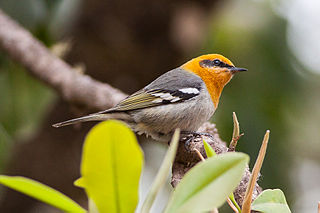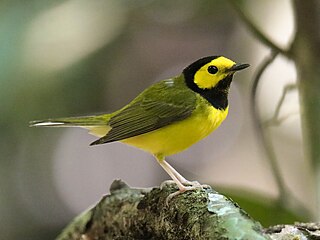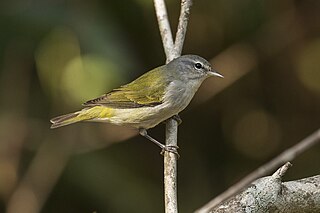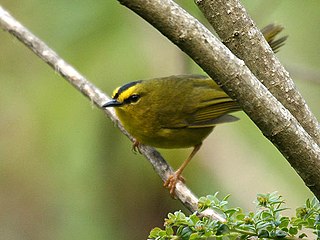
The New World warblers or wood-warblers are a group of small, often colorful, passerine birds that make up the family Parulidae and are restricted to the New World. The family contains 120 species. They are not closely related to Old World warblers or Australian warblers. Most are arboreal, but some, like the ovenbird and the two waterthrushes, are primarily terrestrial. Most members of this family are insectivores.

The olive warbler is a small passerine bird. It is the only member of the genus Peucedramus and the family Peucedramidae.

The bay-breasted warbler is a small species of songbird in the New World warbler family, Parulidae. It is one of thirty-four species in the diverse genus Setophaga. Like all songbirds, or passerines, the species is classified in the order Passeriformes.

The black-and-white warbler is a species of New World warbler, and the only member of its genus, Mniotilta. It breeds in northern and eastern North America and winters in Florida, Central America, and the West Indies down to Peru. This species is a very rare vagrant to western Europe.

The hooded warbler is a New World warbler. It breeds in eastern North America across the eastern United States and into southernmost Canada (Ontario). It is migratory, wintering in Central America and the West Indies. Hooded warblers are very rare vagrants to western Europe.

The blue-winged warbler is a fairly common New World warbler, 11.5 cm (4.5 in) long and weighing 8.5 g (0.30 oz). It breeds in eastern North America in southern Ontario and the eastern United States. Its range is extending northwards, where it is replacing the very closely related golden-winged warbler.

The Tennessee warbler is a New World warbler that breeds in eastern North America and winters in southern Central America, the Caribbean, and northern South America. The specific name peregrina is from Latin peregrinus "wanderer".

The Nashville warbler is a small songbird in the New World warbler family, found in North and Central America. It breeds in parts of the northern and western United States and southern Canada, and migrates to winter in southern California and Texas, Mexico, and the north of Central America. It has a gray head and a green back, and its underparts are yellow and white.

The orange-crowned warbler is a small songbird of the New World warbler family.

Virginia's warbler is a species of New World warbler.

Setophaga is a genus of birds of the New World warbler family Parulidae. It contains at least 34 species. For example, the males in breeding plumage are often highly colorful. The Setophaga warblers are an example of adaptive radiation with the various species using different feeding techniques and often feeding in different parts of the same tree.

Cardellina is a genus of passerine birds in the New World warbler family Parulidae. The genus name Cardellina is a diminutive of the Italian dialect word Cardella for the European goldfinch.

The Cuban warblers are a genus, Teretistris, and family, Teretistridae, of birds endemic to Cuba and its surrounding cays. Until 2002 they were thought to be New World warblers, but DNA studies have shown that they are not closely related to that family. The family consists of two species, the yellow-headed warbler and the Oriente warbler. Both species are found in forest and scrub, with the yellow-headed warbler ranging in the west of the island and the Oriente warbler in the east. The Cuban warblers are 13 cm (5.1 in) long and have similar yellow and grey plumage.

Oreothlypis is a genus of New World warbler. Most members of this genus for formerly classified in the genus Vermivora. However, the species then in Vermivora were more closely related to the flame-throated warbler and crescent-chested warbler, then classed in Parula, than to other species of Vermivora. Initially, the new genus Leiothlypis was proposed for these species by Sangster in 2008, but the American Ornithologists' Union opted to classify them along with the flame-throated and crescent-chested warblers in the existing genus Oreothlypis, though accepted the change in 2019.

Leiothlypis is a genus of New World warbler, formerly classified within the genus Oreothlypis or Vermivora.

Myiothlypis is a genus of New World warblers, best represented in Central and South America. This is one of only two warbler genera that are well represented in the latter continent. All of these species were formerly placed in the genus Basileuterus.



















